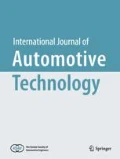Abstract
This study developed a method to evaluate the sound quality of the warning sound masked by background noise considering the masking effect. The warning sound of an electric vehicle is required by law for the safety of pedestrians. Therefore, the warning sound becomes an additional noise pollution source if it is designed as an annoyance. On the other hand, if the sound is designed with a low sound pressure level, pedestrians will not recognize the approach of vehicle due to background noise. To avoid nose pollution and permit the detectability of an approaching vehicle, a method for evaluating the annoyance and detectability of an electric vehicle is required. In this paper, the whine index evaluating the whine sound masked by the background was developed and used as a sound metric. This metric was employed for the development of an annoyance index and detectability index for electric vehicles.
Similar content being viewed by others
Abbreviations
- A:
-
constant related to the amplitude of a monopole source
- P rms :
-
mean squared value of the sound pressure
- q:
-
source strength of a mono pole source
- ρ :
-
density of air
- c:
-
speed of sound
- k:
-
wave number
- r:
-
distance from the source to the listener
- θ :
-
directivity of sound presure
- v:
-
speed of the vehicle
- L(f):
-
sound pressure level (SPL) of the waveform
- L E,n :
-
frequency masking curve of nth masker
- I:
-
noise intensity present in the critical band
- L TH(f):
-
hearing threshold the frequency f
References
Engler, O. (2016). Mercedes-Benz SLS AMG coupé electric drive: NVH development and sound design of an electric sports car. SAE Paper No. 2016-01-1783.
Garay-Vega, L., Hastings, A., Pollard, J. K., Zuschalg, M. and Stearns, M. D. (2010). Quieter Cars and the Safety of Blind Pedestrians: Phase I. National Highway Traffic Safety Administration.
Japan Automobile Standards Internationalization Centre (2009). A Study on Approach Warning Systems for Hybrid Vehicle in Motor Mode. 49th UNECE/WP/GRB.
Jacobsen, G., Ih, J. G., Song, W. and Macdonald, E. (2016). Predicting detectability and annoyance of EV warning sounds using partial loudness. Proc. 45th Int. Congress and Exposition on Noise Control Engineering, 1706–1715.
Kang, H. S., Shin, T. J., Lee, S. K. and Park, D. C. (2015). Design optimization of a dual-shell car horn for improved sound quality based on numerical and experimental methods. Applied Acoustics, 90, 160–170.
Kinsler, L. E., Frey, A. R., Coppens, A. B. and Sanders, J. V. (2000). Fundamentals of Acoustics. 4th edn. John Wiley & Sons. New York, USA.
Lee, S. K. (2016). Objective evaluation of sound quality in an electric vehicle based on effect of temporal and spectral masking. Proc. FISITA 2016, BEXCO, Korea.
Lee, S. K., Kim, H. W. and Na, E. W. (2010). Improvement of impact noise in a passenger car utilizing, sound metric based on wavelet transform. J. Sound and Vibration 329, 17, 3606–3619.
Lee, S. M. and Lee, S. K. (2014). Objective evaluation of human perception of automotive sound based on physiological signal of human brain. Int. J. Automotive Technology 15, 2, 273–282.
Nyeste, P. and Wogalter, M. S. (2008). On adding sound to quiet vehicles. Proc. Human Factors and Ergonomics Society Annual Meeting 52, 21, 1747–1750.
Otto, N., Amman, S., Eaton, C. and Lake, S. (1999). Guidelines for jury evaluations of automotive sounds. SAE Paper No. 1999-01-1822.
Quiet Road Transport Vehicles (QRTV) (2010). Terms of Reference and Rules of Procedures for the GRB Working Group on Quiet Road Transport Vehicles (QRTV). GRB Informal Group on Quiet Road Transport Vehicles (QRTV): Working Papers of the 1st Informal Meeting.
Robart, R., Parizet, E., Chamard, J. C., Janssens, K. and Biancardi, F. (2013). eVADER: A perceptual approach to finding minimum warning sound requirements for quiet cars. AIA-DAGA 2013 Conf. Acoustics, 1.
Singh, S., Payne, S. R. and Jennings, P. A. (2014). Toward a methodology for assessing electric vehicle exterior sounds. IEEE Trans. Intelligent Transportation Systems 15, 4, 1790–1800.
Terhardt, E., Stoll, G. and Seewann, M. (1982). Algorithm for extraction of pitch and pitch salience from complex tonal signals. J. Acoustical Society of America 71, 3, 679–688.
Yasui, N. and Miura, M. (2016). Effect of amplitude envelope on detectability of warning sound for quiet vehicle. Inter-Noise 2016, 1698–1705.
Author information
Authors and Affiliations
Corresponding author
Additional information
This paper was modified from the original paper presented in FISITA World Automotive Congress 2016, and recommended by the Scientific & Technical Committee for journal publication.
Rights and permissions
About this article
Cite this article
Lee, S.K., Lee, S.M., Shin, T. et al. Objective evaluation of the sound quality of the warning sound of electric vehicles with a consideration of the masking effect: Annoyance and detectability. Int.J Automot. Technol. 18, 699–705 (2017). https://doi.org/10.1007/s12239-017-0069-6
Received:
Revised:
Accepted:
Published:
Issue Date:
DOI: https://doi.org/10.1007/s12239-017-0069-6




